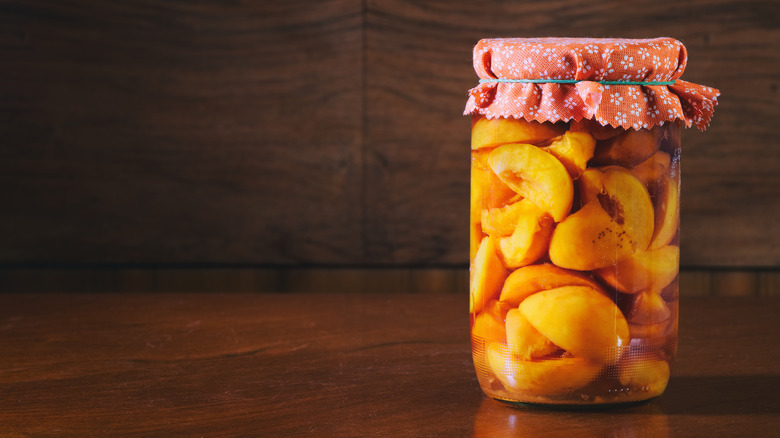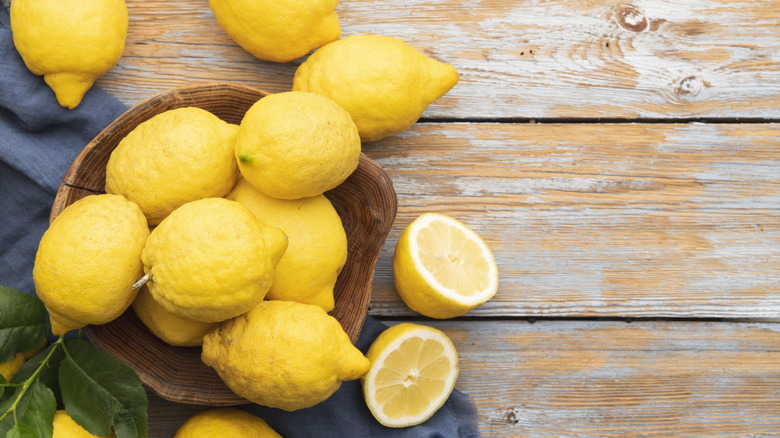The Super Easy Tip To Prevent Your Homemade Canned Peaches From Turning Brown
The process of preserving food via canning was first developed in the early 1800s. Inventor Nicholas Appert created the process in an effort to secure a reward promised by Napoleon Bonaparte, who was looking for a way to sustain French troops on the battlefield. Appert's invention involved applying heat to food contained in glass jars, then sealing the jars to prevent bacterial intrusion. These days, canning is something everyone can do, including industrious homemakers. Along with meats and vegetables, fruit can also be canned at home. Peaches are an excellent selection when it comes to canning, but they can sometimes turn brown during the process.
While it doesn't affect the taste or quality of the fruit, brown peaches are not as pleasing to look at as bright, colorful ones. This issue affects a variety of fruits that contain certain enzymes that can cause chemical reactions. When peaches and other fruits are exposed to open air, these enzymes cause them to turn brown. Fortunately, there's a great canning hack that will keep your peaches looking as amazing as they taste.
A little lemon juice can go a long way
Canning peaches entails numerous steps, such as sterilizing jars, cooking syrup, boiling fruit, and many more. While it's not an integral aspect of the process, submerging fresh peaches in a mix of lemon juice and water will prevent the fruit from turning brown. That way, you can enjoy tasty and good-looking peaches for 18 to 24 months (which is generally how long canned peaches last).
To stop peaches from turning brown, you'll need to give them a cold water and lemon juice bath. This step should take place immediately after blanching, removing the peels, and dunking the fruit in ice water to stop it from cooking. To make your anti-browning concoction, fill a large bowl with water and add one tablespoon of lemon juice. Make sure the bowl is large enough to accommodate all the peaches and avoid overfilling the bowl, as the water level will rise once the peaches have been submerged. For the best results, submerge peaches in the lemon juice-water mix any time you're not working with them. For instance, you should transfer them from the ice water to the lemon juice solution immediately. Once sliced, place the peaches back into the lemon water while you work on the syrup. While this canning hack might seem like magic, rest assured that it has a sound basis in specific scientific principles.
How does lemon juice stop peaches from turning brown?
Lemon juice is not only a great way to add brightness to recipes, but also quite effective at keeping fruit a pleasing and palatable color after it's been sliced. The enzymes responsible for turning the flesh of peaches and other types of fruit brown are most effective when pH levels are neutral. A neutral pH level means that a solution is neither too base nor too acidic. For example, liquid drain cleaner has a pH of 14, which makes it a base solution. On the other hand, battery acid has a pH of 0, making it acidic.
Lemon juice has a pH of 2, which means it's an acidic solution. As a result, it's ideal for stopping the chemical reaction that causes fruit to turn brown. When introducing citrus juice to fruit, the pH is effectively lowered, which deters the chemical reaction that causes browning to take place. The ascorbic acid in lemon juice also forms a protective coating over the fruit to reduce the impact of air exposure. Along with peaches, the lemon juice trick also works on bananas, apples, and pears. With this simple hack, you never need to worry about brown fruit detracting from your recipes again.


